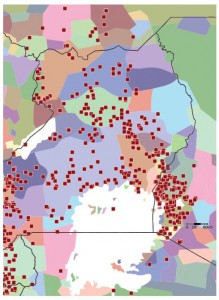- Rice yields and yield gaps in Southeast Asia: Past trends and future outlook. If average farmers became like best-yielding farmers that would meet 2050 needs, except in the Philippines, where some more structural stuff is needed.
- Method of evaluating diversity of carrot roots using a self-organizing map and image data. The sound you hear is that of butterflies being broken on wheels.
- Bioactive compounds from Capparis spinosa subsp. rupestris. Are pretty much the same as those in subsp. spinosa.
- Constitutive Overexpression of the OsNAS Gene Family Reveals Single-Gene Strategies for Effective Iron- and Zinc-Biofortification of Rice Endosperm. So that’s a good thing, right?
- Analysis of climate paths reveals potential limitations on species range shifts. Corridors not the answer. Or not the only answer. Or not the full answer.
- An updated review of Adansonia digitata: A commercially important African tree. Do baobab scientists not sometimes long for the Time Before Reviews, when they actually, you know, did stuff?
- Genetic diversity, population structure and relationships of Tunisian Thymus algeriensis Boiss. et Reut. and Thymus capitatus Hoffm. et Link. assessed by isozymes. Dad, what’s an isozyme? Ah, son, it’s a thing people used in the Time Before DNA. The two species are different, they need to be managed in different ways.
- Potential Impact of Biotechnology on Adaption of Agriculture to Climate Change: The Case of Drought Tolerant Rice Breeding in Asia. Kinda pointless: “in severe drought both the [drought tolerant] and the conventional varieties were either not planted or, if planted, did not yield”.
Nibbles: Moringa, Fungi, Blue potatoes, GRAIN, Nutrition, Maize Day, Sorghum research
- Mexico embraces moringa against malnutrition.
- Get your mushroom spores here. (You’ll need something for the headache the page induces.)
- Scientist Gardener discovers blue potato chips at altitude.
- GRAIN gets altNobel. It’s not the winning. It’s the being nominated.
- Bioversity stuns world with nutrition strategy. While Jess does poo.
- Damn, looks like we missed National Maize Day again.
- How your United Sorghum Checkoff dollars are being spent.
Nibbles: IRRI impact, Peruvian food, Nutritional strategy, Ethnobiology, Street food forum, Mulefoot hogs, Polyculture, Cheeses, Asimina triloba, Protected areas
- Australians justify their investment in IRRI. Now that’s what I call impact!
- Peruvian cuisine takes over the world. But, as Eve points out elsewhere, “We have a thousand kinds of potatoes in Peru, thousands” is not hyperbole.
- Jess scoops the world with a nutrition strategy for the masses.
- Indians need sorghum and millets to keep healthy.
- Ethnobiology: The Book.
- Talking about street food. Hold the mayo.
- Not all pigs are cloven-hoofed. A tetrapod zoologist explains syndactyly.
- Polyculture; is it all Pollyanna? Science will answer.
- A flavour map of British cheeses. You know you need it.
- Foraging for pawpaws. Not those pawpaws.
- Bird areas apps. CWRs next?
Sorghum and ethnicity in Africa
Ever since I contributed to A methodological model for ecogeographic surveys of crops, and suggested that collectors should do this, I’ve been waiting for the time when it would be easy — or even possible — to map the distribution of conserved germplasm on top of cultural, ethnic or language boundaries. The problem has been that maps of such boundaries, 1 though available in various printed formats, have not been much digitized. Or at least I hadn’t come across them. Until I happened on a blog post about the Center for Geographic Analysis’ (Harvard University) WorldMap, an open source web mapping system. The layers provided include one called Ethnicity Felix 2001, which “consist of polygons and labels depicting ethnicity information based on the ‘People’s Atlas of Africa’ by Marc Felix and Charles Meur, Copyright 2001.” Perfect, I thought.

Nibbles: Collecting, US heirlooms, Sequencing NUS, Nutrition strategies, Potatoes and climate change, Italian genetics
- NSF re-invents the genebank wheel. No, that’s unfair, they’ve given much-needed money to evolutionary scientists to go out and collect seeds of 34 species in a really pernickety way.
- Heirlooms being lost (maybe) and being re-found in the US. Thanks to Eve (on FB) for both.
- A Cape tomato by any other name…
- Gates Foundation has a new nutrition strategy. Gotta admire the chutzpah of summarizing the thing in basically half a side of A4. Compare and contrast, both as to content and presentation, with the CGIAR. Unfair again, I know, but that’s the kind of mood I’m in. Jess unavailable for comment.
- Very complicated, very pretty maps about potatoes and climate change.
- “I failed to notice substantial contributions to discussions or presentations from breeders or seed organizations, the end users of so much of the research discussed.” Pat Heslop Harrison calls ’em like he seems ’em.